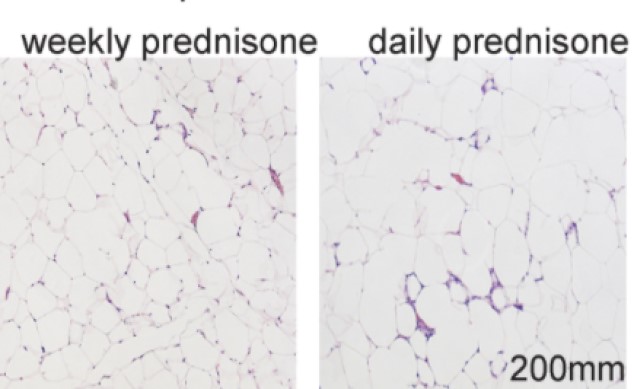Obesity and Prednisone: Weekly Dose ‘Strikingly Different’ Outcomes vs. Daily
Research By: Mattia Quattrocelli, PhD
Post Date: April 1, 2022 | Publish Date: April 1, 2022


In mice, weekly prednisone promotes nutrient uptake into muscles and improves lean body mass
Obese mice that received prednisone one time per week had improved exercise endurance, got stronger, increased their lean body mass, and lost weight, reports a new study from Cincinnati Children’s and Northwestern University.
Details were published online April 1, 2022, in the Journal of Experimental Medicine.
The once-weekly prednisone promoted nutrient uptake into the muscles. The mice also had increased muscle metabolism.
Investigators found these mice had increased adiponectin levels, a fat-derived hormone that appears to play an important role in protecting against diabetes and insulin resistance.
The scientists also showed mice that were already obese from eating a high-fat diet also had benefit after once-weekly prednisone, experiencing increased strength, running capacity and lower blood glucose.
“These studies were done in mice. However, if these same pathways hold true in humans, then once-weekly prednisone could benefit obesity,” says senior author Elizabeth McNally, MD, PhD, director of the Center for Genetic Medicine at the Northwestern University Feinberg School of Medicine.
“Daily prednisone is known to promote obesity and even metabolic syndrome—a disorder with elevated blood lipids and blood sugar and weight gain,” McNally says. “So these results, in which we intermittently ‘pulse’ the animals with once-weekly prednisone, are strikingly different. Obesity is a major problem, and the idea that once-weekly prednisone could promote nutrient uptake into muscle might be an approach to treating obesity.”
Most of what doctors know about steroids like prednisone comes from studies looking at what happens when prednisone, a glucocorticoid steroid, is taken every day.
“We see a very different outcome when it is taken once a week,” McNally says. “We need to fine tune dosing to figure out the right amount to make this work in humans, but knowing adiponectin might be one marker could provide a hint at determining what the right human dose is.”
McNally described the weekly dose as “a bolus, or spike, of nutrients going into your muscle.”
“We think there is something special about promoting this spike of nutrients into muscle intermittently, and that it may be an efficient way to improve lean body mass,” she says.
“What is exciting to me about this work is the finding that a simple change in the dosing frequency can transform glucocorticoid drugs from inducers to preventers of obesity,” says corresponding author Mattia Quattrocelli, PhD. “Chronic once-daily intake of these drugs is known to promote obesity. Here we show that dosing the same type of drug intermittently—in this case, once weekly—reverses this effect, promotes muscle metabolism and energy expenditure, and curtails the metabolic stress induced by a fat-rich diet.”
Quattrocelli worked on the research while in McNally’s lab at Northwestern then completed the project in his own lab at Cincinnati Children’s.
Can weekly dosing still benefit patients with immune conditions?
Many patients take prednisone daily for different immune conditions. Known side effects of daily prednisone include weight gain and even muscle atrophy with weakness. Investigators want to determine whether patients can get the same immune benefit with intermittent prednisone dosing, which could be much more beneficial to the muscle.
Research began in muscular dystrophy
In previously published research, McNally’s team discovered giving prednisone intermittently was helpful for muscular dystrophy, showing once weekly prednisone improved strength.
The group also recently reported findings from a pilot trial in humans with muscular dystrophy in which one weekly dose of prednisone improved lean mass.
Read more about the muscular dystrophy findings
Not one-size-fits-all for prednisone dosing
People have different responses to prednisone dosing.
McNally wants to determine which biomarkers are most critical to mark having a beneficial response to prednisone.
“If we can determine how to choose the right dose of prednisone that minimizes atrophy factors and maximizes positive markers like adiponectin, then we can really personalize the dosing of prednisone,” she says.
The group also recently showed that weekly prednisone uses strikingly different molecular pathways to strengthening the muscle in male versus female mice, based on a new study just published in the Journal of Clinical Investigation.
The circadian connection
The benefits of weekly prednisone are linked to circadian rhythms, reports another new study from Northwestern and Cincinnati Children’s published last month in Science Advances.
Human cortisol and steroid levels spike early in the morning before you wake up.
“If you don’t give the drug at the right time of day, you don’t get the response,” Quattrocelli says. “In mice, we obtained good effects with intermittent prednisone in muscle mass and function when we dose them at the beginning of their daytime. Mice have a circadian rhythm inverted to us, as they generally sleep during the daytime and are active at night. This could mean that the optimal dosing time for humans during the day could be in the late afternoon/early evening, but this needs to be appropriately tested.”
Do stronger, leaner mice equal stronger, leaner humans?
The major caveat is that these studies are conducted in mice, McNally says.
“While we are encouraged by the pilot study in humans with muscular dystrophy, mouse muscles have more fast-twitch fibers than humans, and slow-twitch muscle could be different,” McNally says. “More studies are needed to try to better understand whether these same mechanisms work in human muscles.”
About the study
The study was funded by National Institutes of Health (DK121875, HL158531, AG049665, AR052646 and HL061322) and a Cincinnati Children’s Heart Institute Translational Grant.
| Original title: | Intermittent prednisone treatment in mice promotes exercise tolerance in obesity through adiponectin |
| Published in: | Journal of Experimental Medicine |
| Publish date: | April 1, 2022 |






